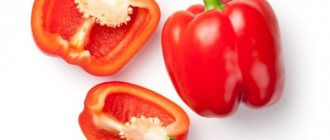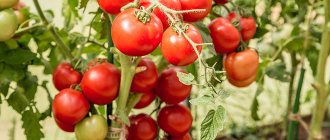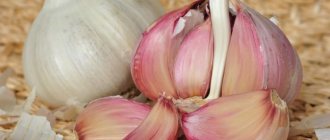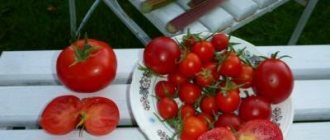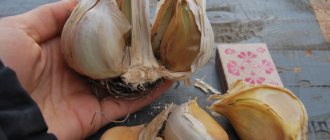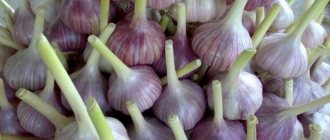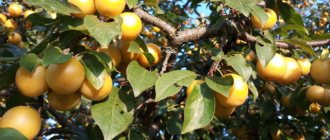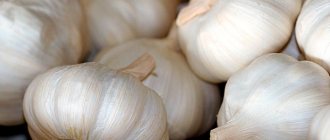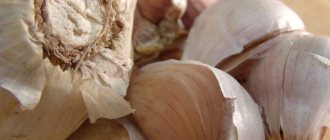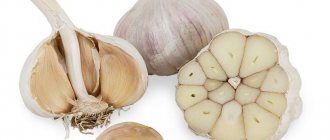Botanical features of the Lyubasha variety
The shoots of Lyubasha garlic grow to a maximum of 1.5 m. The average size of the crop is 1–1.2 m. The green leaves are narrow (2–2.5 cm) and long (40 cm). The heads, whose weight ranges from 60 to 350 g, are more often born 100 grams and are covered with white scales with purple stripes. One commercial head consists of 4–7 pale cream teeth.
Lyubasha is a medium-ripening variety of garlic with a pungent taste and a persistent aftertaste. The vegetable ripens within 3 months from the moment of germination.
Description and characteristics of Lyubasha garlic
The Lyubasha variety is a universal winter garlic variety that produces high yields and is resistant to sudden temperature changes. It is resistant to parasites and bacterial diseases, tolerates drought and rainy weather well, and therefore grows in all regions of the CIS. The variety is resistant to fungal diseases, its immunity protects it from common pests.
Garlic heads grow large and hard, in a white, slightly pinkish husk, contain up to 7 cloves, and weigh up to 120 grams. The slices have a pungent taste and a pleasant spicy aroma, each of them weighs about 10-20 grams. The vegetable ripens within 87-98 days. When grown in summer, garlic bushes grow up to 150 cm, overgrown with bright emerald green dense foliage. Many people eat both cloves and leaves of garlic.
Description of garlic: main advantages and disadvantages
Positive characteristics of Lyubasha garlic:
- cultivation of crops in different climatic zones;
- high productivity;
- large size of bulbs and cloves, marketable appearance, in demand for sale;
- keeping quality;
- universal purpose;
- portability of transportation while maintaining the original shape and other characteristics;
- pronounced, rich taste;
- high content of essential oils;
- low requirements for irrigation;
- immunity to diseases and pests;
- resistance to winter frosts, spring return frosts;
- Long-term fresh storage – up to 10 months.
Among the disadvantages, farmers and gardeners highlight:
- high labor costs when removing arrows;
- the need to mulch the soil before the onset of cold weather;
- intolerance to shady places.
Depending on tastes and preferences, large onions and cloves are both a plus and a minus of the crop.
Advantages and disadvantages
- Shelf life when stored correctly is 10–11 months.
- Tolerates long-term transportation.
- Cold resistance.
- Stress-resistant to weather.
- Tolerates lack of moisture.
- Withstands pest attacks.
- Resistant to fungal diseases, not affected by fusarium.
- Undemanding in care.
Lyubasha has no serious shortcomings if the requirements of agricultural technology are met:
- Requires a sunny place, does not grow well in the shade.
- If there is not enough snow, it can freeze without mulching.
Winter crop yield
The productivity of Lyubasha garlic depends on care and favorable weather conditions. Even in dry summers, the variety produces up to 35 centners of vegetables per hectare .
Increases productivity by removing 10-centimeter shoots and applying fertilizers. Depending on the region, bulb harvesting lasts from the last ten days of June to the end of July. When performing all agrotechnical work, gardeners receive 2–3 kg of bulbs per 1 sq.m.
Care
To grow Lyubasha garlic and get a generous harvest of bulbs, you need high-quality plant care, which consists of regular watering, fertilizing, weeding, and loosening the soil. The first fertilizing is carried out soon after germination to allow the plants to fully develop. During the entire growing season it is carried out 2-3 more times.
Despite the fact that the variety tolerates drought well, it cannot do without irrigation at all. Depending on the region, it is necessary to water the plantings 1-2 times a week. Moisture is needed not only for the growth of stems, but also for the formation of heads. Watering is stopped 2 weeks before harvesting.
Resistance to diseases and pests
The immune defense of Lyubasha garlic is not susceptible to fusarium, but the culture is affected by green mold, black and neck rot. Disinfecting soil treatment, drying the crop and creating suitable storage conditions - humidity up to 70%, temperature 0-2°C - helps in the fight against fungal infection.
The bactericidal properties of garlic repel many types of pests. The main enemy of the crop is nematodes, against which there are no effective treatments.
To prevent infection with microscopic roundworms, it is recommended to change the planting site every 2 years.
Diseases and pests, methods of control and prevention
The Lyubasha variety is resistant to parasites and bacteria. It is resistant to fusarium and onion fly. However, you should not neglect preventive methods of protection:
- Treat the soil and seeds with insecticides and disinfect with a manganese solution.
- Sprinkle the beds with wood ash.
- Maintain crop rotation.
- Spray seedlings with fungicides.
If the plant is nevertheless affected by bacterial diseases, all seedlings should be treated with the Fitosporin fungicide. In this case, already infected plants should be destroyed.
Scope of harvest
Lyubasha garlic is used in cooking for canning, pickling, and is added as a seasoning to first and second courses and sauces. The leaves of the crop are included in salads, stewed, and fried.
The vegetable is widely used in official and folk medicine. Garlic is included in pharmaceutical preparations and folk remedies used in the treatment of the following diseases:
- pulmonary tuberculosis;
- colitis, gastritis, cholecystitis;
- hypertension, atherosclerosis;
- diabetes mellitus;
- dysentery;
- staphylococcal infection;
- flu, sore throat, pneumonia.
Garlic prevents excess weight gain and senile dementia.
Kills cancer cells developing in the oral cavity and bronchi, strengthens the body's immune defense.
What is the difference from other varieties?
High frost resistance determines the cultivation of Lyubasha garlic in the northern regions of Russia. The crop produces a consistently high yield even in areas with high temperatures and limited precipitation, since the plant is distinguished by increased resistance to drought.
See also
Description of Suvorov garlic Anzur and cultivation rules
Read
Lyubasha's high immunity determines the survival of garlic during the penetration and reproduction of spores of pathogenic fungi without the use of chemicals, which leads to an environmentally friendly harvest.
Advantages and disadvantages
Gardeners prefer to plant Lyubasha instead of other varieties, because this variety has incomparable advantages. Among them:
- high yield - farmers harvest about 30-35 centners of garlic per 1 hectare per season;
- excellent shelf life - the harvested crop can be stored in basements and storerooms for up to 10 months without loss of quality;
- resistance to diseases and parasites - any variety of garlic suffers from fusarium, but Lyubasha’s immunity allows farmers to forget about this disease;
- drought resistance - the variety grows well in hot, arid climates, while giving an excellent harvest;
- transportability – garlic can withstand long stays on the road, so it is excellent for sale;
- frost resistance - the winter variety tolerates frost and sudden temperature changes well even in the harshest climates.
The disadvantages of the variety include its love for light - garlic can only be planted in sunny places in the summer, otherwise the seedlings will die. Another disadvantage is the need for high-quality mulching when planting for the winter - if there is not enough snow, the winter garlic will die.
Requirements for growing conditions
To grow crops, it is important to observe soil and climatic conditions. Lyubasha garlic grows normally at a temperature of 17-25°C. Loves cultivated, nutritious soils.
The bulbs grow small when grown in shaded areas, on low-humus and acidic soil. The vegetation is slowed down by the lack of soil aeration through loosening and insufficient irrigation.
Part of the harvest is lost due to diseases when garlic is planted in the same beds for more than two years and when there is excessive watering.
The Lyubasha variety, due to its winter hardiness and drought resistance, is grown in all regions of the Russian Federation. Only the timing of planting and the depth of planting vary.
When sprouting, the vegetable requires a humidity of 80%. As you grow, this figure drops to 60%.
Garlic “Lyubasha”
Details about the garlic variety
We can only recommend this or that variety; in any case, you can decide which plants and vegetables to grow on your plot yourself. So with the “Lyubasha” garlic variety, when choosing this variety, it is important to know all the features and characteristics of the variety, its advantages and disadvantages over other types of garlic, and most importantly, to know and use in practice the basic needs for growing and caring for garlic.
Garlic variety
with the affectionate name
“Lyubasha”
is quite common and popular among gardeners, the variety belongs to the mid-season varieties of garlic, the variety bolts. The variety is a hybrid, its selection allows it to tolerate cold and drought well, which means this variety of garlic is suitable for planting and growing in various climatic zones and regions of Russia, from the Krasnodar Territory to the Urals. Another distinctive feature is the ability to preserve its presentation - garlic is ideal for long-term storage. The variety can be stored for up to 10 months.
As we said above, the garlic variety “Lyubasha”
shoots an arrow - the garlic stalk can grow up to 120 cm, and in some cases the height can reach 150 cm. Garlic leaves are dark green in color, the length of the leaf grows from 35-45 cm, the width of the leaf is from 2 to 2.5 cm.
Onion – head of garlic “ Lyubasha”
” has a flattened shape, the head is large; its average weight is 110-125 grams; with proper care of garlic, you can grow a head weighing up to 375 grams; such cases have happened among gardeners. The head of garlic is white, may have a pink tint with purple veins.
How to plant a bulbous plant on a plot
Planting is an important agrotechnical event on which the future harvest depends. It is not enough to bury the cloves or bulbs in the garden bed. In order for the plant to develop properly, a site is selected, taking into account crop rotation, planting material and soil are prepared, and sowing dates are determined.
Boarding time
The winter garlic variety Lyubasha is planted from early October to mid-November, depending on the climatic zone and weather conditions. It takes 3 weeks before frost for the crop to take root. If planted ahead of schedule, the plant will sprout seedlings that will die.
The optimal soil temperature for sowing garlic is 10-12°C.
We calculate the seeding rate per 1 ha
When planting cloves, planting material requires 1-1.5 thousand kg per 1 ha, depending on the fraction. Aerial bulbs are sown at the rate of 50–60 pieces per linear meter or 100–200 kg per 1 ha, depending on the size.
Choosing a landing site
Lyubasha garlic requires a flat, open, sunny place. Highlands are unsuitable due to snow blowing and freezing in winter, and lowlands are unsuitable due to spring flooding. The crop loves fertile, slightly acidic, loose soil.
When choosing a bed, predecessors are taken into account. If in the previous year melons, legumes, all types of cabbage, cucumbers and greens grew on the plot, then this is a suitable place for garlic.
It is not recommended to plant the crop after nightshades, onions, and carrots.
Preparing the ridges
A month before planting winter garlic Lyubasha, weeds are removed, the beds are leveled and the soil is dug up using a spade. Humus is added at the rate of 10 kg per 1 sq.m and phosphorus-potassium fertilizers - 1 tbsp. l. superphosphate, 2 tbsp. l. potassium sulfate.
Digging in advance is necessary to settle the soil in order to prevent the cloves from being pulled deeper. For the same purpose, the ridge is watered 2-3 times a month. Immediately before sowing, nitroammophoska is added to the ground.
Using cow manure before planting leads to an increase in green mass to the detriment of the formation of heads.
Preparation of planting material
When preparing planting material for Lyubasha garlic, the following activities are performed:
- disassemble the bulbs into individual cloves;
- sort the cloves - discard dried, deformed, disease-damaged specimens;
- divide the material into fractions depending on size;
- disinfect the teeth for 2 hours in a weak solution of manganese (1 g of dry matter per 1 liter of water).
Planting material gradually degenerates, so renewal is required every 5 years.
The process of planting planting material
Aerial bulbs and mature cloves are buried 6–7 cm, maintaining a distance in the row of 10 cm, and between rows of 30–40 cm, and sprinkled with earth.
There is no need to water, the soil is moistened the day before.
For uniform illumination during daylight hours, it is recommended to place rows from north to south.
See also
When can you harvest garlic in 2021 according to the lunar calendar, terms and storage rules
Read
How to grow
Let's study the stages of cultivation in detail .
Landing
Experienced gardeners recommend planting garlic according to the following scheme: 1 plant for every 10 cm in a row and 30-40 cm between rows .
The optimal planting depth for Lyubasha garlic is 8-10 cm (the larger the cloves, the deeper they are planted). After planting, it is recommended to mulch the beds with a layer of 4 cm. This is especially necessary in the northern regions, where frosts can lead to the death of plantings in winter.
Be sure to weed the soil and eliminate weeds, as they attract pests.
Care
The Lyubasha variety does not require special care. There are two requirements:
- removing weeds in the place where garlic is planted;
- timely watering of planted plants.
Attention! Unlike other varieties, Lyubasha garlic is suitable for any region and climatic conditions. It is more resistant to diseases caused by fungal microflora.
From mid-April, the crop needs regular watering .
In this case, it is necessary to control the amount of moisture in the root system. Too much water will kill the garlic. The vegetable tolerates drought well . But it is better not to allow the soil to dry out completely. It is optimal to water the crop at least 1-2 times a week.
To increase productivity, farmers recommend feeding Lyubasha 3-4 times a season, using complex mineral compositions for these purposes. Fertilizers are applied simultaneously with watering (it is best to dilute the preparations with water; in a dry form they are less easily absorbed).
The first feeding is carried out immediately after seedlings appear on the surface of the earth. At this stage, you can use regular urea (20 g per bucket of water). If the bed is not mulched, it is useful to add organic matter, for example, mullein, to the mineral fertilizing.
The second feeding is carried out 2 weeks after the first . The fertilizer should contain potassium, phosphorus and nitrogen. A good option is “Nitrophoska” or “Nitroammofoska”. In a bucket of water you need to dilute 2 tbsp. l. substance and use it to water approximately 3 m² of bed.
More about garlic:
A selection of the best methods for preserving garlic
Saving the harvest from the cold
Diseases and pests
The Lyubasha variety is resistant to fusarium and other diseases and pests. But weakened plants can be attacked:
- pathogenic microorganisms (downy mildew, bacteriosis, neck rot, black mold);
- pests (onion fly, stem nematode, onion hoverfly, secretive proboscis, root mite and others).
If feather growth is slow during the growing season , this means that the plant does not have enough nutrition. To eliminate this problem, you need to feed with the following composition: 1 tablespoon of urea and 1 glass of bird droppings per 10 liters of water.
Feathers of a bluish-white color are a sign of a lack of moisture, a pale green tint is an excess of moisture; watering should be limited.
We organize plant care
Mulching, watering, soil aeration and fertilization increase yields by 25–30%.
Mulching
Mulch Lyubasha garlic immediately after planting with a thick 5–10 cm layer. The following is used as mulch:
- spruce branches or coniferous needles;
- peat;
- fallen leaves;
- cut grass;
- straw.
If the winter is not too severe, the crop will survive without mulch. But this event also has other tasks - nutrition, inhibition of weed growth, moisture retention.
Irrigation of bushes
Despite the drought resistance of the crop, it is recommended to water Lyubasha garlic once a week, avoiding stagnation of water and drying out of the top layer of soil. Irrigation is especially important during the period of bulb formation. As the heads mature, they reduce the frequency and volume of watering, negating the harvest date.
Irrigation is stopped three weeks before the garlic reaches technical ripeness.
Fertilizer application
A fully fertilized bed before and during planting does not exempt you from fertilizing in the spring.
As soon as the first green leaves of garlic appear, the ground is watered with a solution of ammonium nitrate or urea (2 tablespoons per bucket of water).
After two weeks, the culture is fed with infusions:
- nettle (1 kg of grass per 5 liters of water);
- chicken manure (1:20);
- mullein (1:10).
For the third time in early June, the plants are watered with dissolved ash. For 1 sq.m. A bucket of water and a glass of ash are required. Or they use ready-made fertilizers with an emphasis on phosphorus and potassium - double superphosphate, potassium sulfate, monophosphate.
Weeding and loosening the soil
In the spring, after removing the mulch from the garden bed, the weeds are the first to make their way to the sun, sucking nutrients from the soil. To combat them, regular weeding is carried out.
Loosening the soil after each rain or artificial watering provides aeration and better moisture permeability.
Experienced vegetable growers leave mulch on the garden bed for the entire growing season, thereby making it easier to care for the crop. Mulching does not require weeding, loosening the soil, and reduces the amount of irrigation due to moisture retention.
Step-by-step instructions for care and planting
Where and for how much can I buy seed material?
- Online store “Variety seeds”, Barybino village, Moscow region. Bulbs, 10 pcs. 10-30 rub.
- Online store “Russian vegetable garden”, Shchelkovo, Moscow region.
- In Moscow and St. Petersburg, they purchase via the Internet through advertisements from individuals and farmers.
- In online stores in Volgograd, Chelyabinsk, Krasnodar, packaging - 10 units, cost: 170 rubles, 3 units - 49 rubles.
Boarding time
It is better to plant garlic in the fall from late October to mid-November 3-4 weeks before the first frost , otherwise it will die. In the spring, on damp ground after the snow melts, no later than mid-April.
Selection of location and soil
A neutral, loose one is required. High-quality digging to 30 cm to give looseness and airiness.
Plant every year in a new place, sunny, protected from the wind , without groundwater. Areas after:
- cabbage;
- greenery;
- melons;
- legumes
Attention : Do not plant garlic after tomatoes or onions.
Rooting
Before planting, add 12 liters of humus and a liter of wood ash per 1 m2.- 2 days before planting, disinfect with a weak salt solution.
There are three options for breeding Lyubasha:
- seed bulbs, or “balloons”;
- single-toothed ones, which grew from bulblets in the second year;
- teeth from mature heads.
The disadvantage of mature ones is that when planted, they degenerate every year, the taste deteriorates, and the plants get sick.
- The bulbs are sorted by size and disinfected.
- Large areas are planted with trailed seeders.
- Large bulbs are planted at the end of June and, without replanting, are left to overwinter.
Teeth obtained from bulbs after a year can be left in place . When planting in a new place, disinfect. Growing garlic from bulbs is troublesome (two-year cycle), but economical, and the planting material is renewed.
- For the cloves, make 2 cm holes.
- Harden for 14-21 days in the refrigerator.
- Take out a day before planting, disinfect with cherry blossom manganese solution or Fitosporin for 15-20 minutes. They use stimulants - Epin and Prestige, sodium humate for early germination and nutrition.
- Planting with a wide part, add soil.
- Water with a mixture of ammonium sulfate and water 2 tbsp. l. for 10 l per 1-2 m².
- Add soil and mulch.
Temperature
When planting in spring, the soil temperature is +10 - +15 degrees . Podzimny actively grows at +2, if lower, it will not have time to acclimatize and die. The most optimal mode for spring growth is +16 - +20 degrees.
Watering
First watering at the end of April. In the morning or evening hours. Watering is stopped 14 days before harvest. In hot weather, water every week. Not required in autumn.
Abundant watering until mid-June. Untimely watering of a winter variety during a dry summer can destroy the crop . Water consumption depends on the type of soil and planting location. Do not flood the soil or allow it to dry out.
Advice : After watering, carry out weeding with loosening.
Top dressing
Feed:
- chicken droppings;
- rotted cow or horse manure;
- fertilizers with potassium and phosphorus every 10 days;
- In spring, fertilize with nitrogen fertilizers (in liquid form).
Chernozem is added twice - in April and June. The third feeding 14 days before the expected collection .
Harvest and storage
The yellowing of the leaves indicates that the bulbs are ready for harvesting. In June–July, the formed heads of Lyubasha garlic are dug up, the soil is shaken off, and hung in bunches under the roof of the shed to dry.
Storage methods:
- the plants are braided, placed in a nylon stocking, and taken to a cool place;
- vegetables are placed in cardboard boxes, covered with onion peels or sprinkled with salt;
- dip garlic in melted wax;
- the bulbs are placed in linen bags, previously soaked in a concentrated saline solution, and placed in the vegetable compartment of the refrigerator;
- Store the heads in pasteurized jars.
Before storing Lyubasha garlic for storage, cut off the stem, leaving a 5-centimeter stump, and shorten the roots to 1 cm.
Why choose the Lyubasha variety?
Also check out these articles
- Covering material for beds
- Green grape varieties
- How to store cabbage in the cellar in winter
- Bee family
From year to year, some gardeners grow Lyubasha garlic in their dachas and garden plots. Why? Is it that good or just easy to grow?
Average yield per hectare 35-36 centners
- Not only the cloves, but also the green feathers have excellent taste.
- Shelf life 10 months.
- Lyubasha is a hybrid, and therefore has stable immunity to many diseases.
- Not afraid of severe frosts and drought.
- Minimum care - only the most important procedures.
- Can be grown mechanized or manually.
- The average yield per hectare of land is 35-36 centners.
Now about the disadvantages. Gardeners note that the variety has no serious drawbacks if you approach its cultivation correctly.
- Lyubasha garlic grows only in sunny areas. Cultivation in the shade will result in the development of a small head.
- If there is not enough snow in winter and without mulching, crops may freeze.
But all these are common disadvantages that apply to all types of winter garlic, so the variety stands out favorably against the background of other varieties.
Reproduction methods
Winter garlic Lyubasha is propagated in three ways:
- bulblets obtained from the inflorescence of arrows;
- teeth that make up the head;
- single-toothed plants growing from aerial bulbs.
Each of the three types of planting material is sown in the same way. The only difference is the embedment depth. For bulbs, 6 cm is enough, while for cloves, holes with a depth of 7 cm are prepared.
